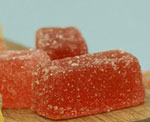Balsamic Vinegar
Types & History
"When it comes to the many TYPES of balsamic vinegar
being sold, it's buyer beware!"
Traditional balsamic vinegar has been made for over 1000 years in the northern Italian region of Emilia-Romagna, in the provinces of Reggio Emilia and Modena. 
From 1300 to 1860 this region was a Duchy ruled by the Este family who were particularly linked to the production and usage of traditional balsamic vinegar. Throughout this time period this precious liquid can be found in notarial deeds recording weddings, inheritances and donations. Records dating back to 1046, show that some of this highly regarded product was even given as a gift to emperor Henry III by the lord of Canossa.
The name balsamic comes from balsam and balm which refer to its attributed medicinal properties since it was used to sooth and heal and to protect against the plague.
Until the 1970's, this traditional vinegar was produced for family use only. It was made in the attic of houses in wooden aging barrels and both the process and the equipment were passed on from generation to generation.
During the 1980's however, the popularity of balsamic soared to the point where demand greatly outpaced the supply of the local families. To meet this worldwide demand, some producers started making this vinegar quickly using non traditional methods and ingredients and it is this inexpensive imitation balsamic vinegar which is readily available in most local supermarkets.
Traditional production method
Real Aceto Balsamico Tradizionale, the Italian name for traditional balsamic vinegar, is a dark mahogany colored viscous liquid which is at the same time both sweet and sour and full of subtle aromatic flavors.
Local grapes, such as the white Tribbiano and the red Lambrusco varieties, are harvested at the very end of the season to maximize their sugar content. They are then crushed and the resulting juice (or must) is then cooked in a large open pot over a direct flame and simmered for a day or so.
Once the evaporation stage has been completed, the juice will have been reduced by about half into a sweet syrup and allowed to cool before transferring to a large ventilated barrel. Yeasts in the air ferment most, but not all of the sugar into alcohol and then aceto bacter bacteria in the air convert the alcohol into acid. The vinegar is then aged for a minimum of 12 years in a series of progressively smaller wooden barrels, called a batteria.
The batteria consist of at least 3 and up to as many as 7 barrels ranging in capacity from 100 to 10 liters. Each barrel, made from a different type of wood such as oak, chestnut, mulberry, juniper, ash and cherry, imparts color and a unique flavor to the finished product.
To allow for air circulation, the barrels are only filled to about 70% capacity and over the course of a year further evaporation claims from 15% to 30% of the liquid. Yearly each barrel is topped up using liquid from the next larger one beside it and the last and largest barrel is replenished with freshly cooked grape juice.
In the following video you can see an actual Italian batteria and how the balsamic vinegar is moved from one barrel to the next.
To be sold as traditional balsamic vinegar a minimum of 12 years aging is required.
If all goes well, the patient vinegar maker using this unique process, can expect to make about 3 liters of this traditional vinegar from 25 liters of cooked grape must in 12 years time. Once completed, the vinegar must then be tested by a panel of judges and only if it passes their strict quality and taste tests will it be awarded the DOC label allowing it to be sold as traditional balsamic vinegar. No wonder the price of Aceto Balsamico Tradizionale can be upwards of $100 for a 3.5 ounce bottle.
There is also an " Aceto Balsamico Tradizionale di Modena DOP ExtraVecchio"![]() that requires a minimum of 25 years of aging.
that requires a minimum of 25 years of aging.
Excellent examples of both the traditional balsamic and the "extra vecchio" 25 year aged vinegar, can be obtained online using the links below:
Other balsamic vinegar Types
The "condimenti" grade is made exactly the same way as the traditional vinegar except it is aged for less than 12 years. As a result it is more affordable and it is especially popular in Italy.
Popular examples of the "condimenti" grade product include the MiaBella, Cavalli, and San Giacomo Balsamic Condimento shown in the links below:
The "industriale" grade is produced quickly and on a much larger scale and can have ingredients added other than just cooked grapes to impart, as much as possible, the look and taste of real traditional balsamic vinegar. Although not nearly as good as the other two grades, industriale is widely used in the everyday cooking of soups and sauces.
There are also many imitation balsamic vinegars on the market which are nothing more than red wine vinegar diluted with water and mixed with other ingredients such as caramel and cane sugar.
So it's buyer beware when choosing a suitable balsamic vinegar. Always read the product label carefully.
Balsamic vinegar Recipes
1) Olive Oil and Balsamic Vinegar Dipping Sauce (Serves 4)
- .......Ingredients........
- 1 cup extra-virgin olive oil
1/2 cup balsamic vinegar
1 teaspoon chili pepper flakes
1 garlic clove, minced
2 tablespoons parsley, minced
2 tablespoons fresh basil, chopped fine
Combine all ingredients in a shallow bowl and refrigerate for 3 to 4 hours.
Use as a dipping sauce for warm crusty bread or vegetables.
2) Traditional Italian bread salad (Serves 4)
- .......Ingredients.......
- 7 slices of Italian crusty bread
1 cucumber, peeled and sliced
1 Spanish onion, sliced
6 large red tomatoes, sliced
1/4 cup (10 g) basil leaves, chopped
6 tablespoons (90 ml) extra-virgin olive oil
3 tablespoons (45 ml) balsamic vinegar
pepper, freshly ground- to taste
The bread should be soaked in cold water for 2 minutes
Tear the bread into small pieces and place in a wooden serving bowl.
Add the cucumber, onion, tomatoes and chopped basil leaves.
Combine the olive oil and vinegar in a separate bowl then mix into the salad.
Add pepper to taste then chill in refrigerator for 1 hour.






